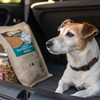Can Dry Dog Food Be Left in a Hot Car? Essential Insights for Pet Owners
- Houndsy
Table of Contents
- Introduction
- Understanding Dry Dog Food
- The Impact of Heat on Dry Dog Food
- Can You Leave Dry Dog Food in a Hot Car?
- Best Practices for Storing Dry Dog Food
- Conclusion
- FAQ
Introduction
Imagine this: you’ve just returned from a long day of errands, and as you open your car door, a wave of heat hits you. You glance at the bag of dry dog food resting in the back seat, and a nagging question creeps into your mind—Can dry dog food be left in a hot car? This scenario is all too common for pet owners who juggle busy lives with the needs of their furry companions.
As devoted pet parents, we want to ensure our dogs receive the best care possible, including the food we provide them. However, many of us may not fully understand how extreme temperatures can impact the quality of dry dog food. In this post, we’ll explore the effects of heat on dry kibble, best storage practices, and how to maintain the nutritional integrity of your dog’s food.
By the end of this article, you’ll have a comprehensive understanding of whether it’s safe to leave dry dog food in a hot car, along with actionable tips to keep your pup’s meals fresh and nutritious. So, let’s dive into this critical topic and consider our own feeding routines as we navigate the world of pet care.
Understanding Dry Dog Food
What Is Dry Dog Food?
Dry dog food, often referred to as kibble, is a popular choice among pet owners due to its convenience and shelf stability. It typically contains a blend of protein, carbohydrates, fats, vitamins, and minerals, ensuring a balanced diet for dogs. The manufacturing process involves cooking the ingredients at high temperatures, which kills bacteria and helps preserve the food.
The Composition of Dry Dog Food
To understand how heat affects dry dog food, it’s essential to know its composition. Most kibble contains:
- Proteins: Derived from meat, fish, or plant sources.
- Carbohydrates: Such as grains, vegetables, or legumes.
- Fats: Essential for energy and nutrient absorption.
- Vitamins and Minerals: Added to support overall health.
Each of these components can be sensitive to temperature changes, particularly fats, which can become rancid when exposed to heat.
The Impact of Heat on Dry Dog Food
Rancidity and Nutritional Degradation
When dry dog food is left in a hot environment, several issues can arise:
- Rancidity: The fats in the food can spoil, leading to rancid odors and flavors. This not only affects the palatability of the food but can also cause digestive upset in dogs.
- Nutritional Loss: High temperatures can degrade essential vitamins and minerals. For example, some vitamins, particularly vitamin C and certain B vitamins, are heat-sensitive and may lose potency when exposed to high temperatures for extended periods.
The Ideal Storage Temperature
Pet food manufacturers recommend storing dry dog food in a cool, dry place, ideally below 100°F (38°C). Prolonged exposure to temperatures above this threshold can significantly shorten the food’s shelf life and compromise its nutritional value.
The Role of Humidity
While heat is a significant factor, humidity plays a crucial role in food preservation as well. Moisture can lead to mold growth, insect infestations, and spoilage, especially when combined with heat. Therefore, it’s essential to consider both temperature and humidity when storing dry dog food.
Can You Leave Dry Dog Food in a Hot Car?
Short-Term vs. Long-Term Exposure
The answer to whether dry dog food can be left in a hot car depends on the duration of exposure:
-
Short-Term Exposure: If you accidentally leave a bag of dry kibble in your car for a few hours during a hot day, the food may still be safe for your dog to eat. However, if the temperature inside the car is excessively high (above 100°F), it’s best to check the food for any signs of spoilage before serving.
-
Long-Term Exposure: Leaving dry dog food in a hot car for days or weeks is highly discouraged. The cumulative effects of heat and potential moisture can lead to rancidity, loss of nutritional value, and even mold growth. If you find yourself in this situation, it’s safer to discard the food and purchase a fresh bag.
Signs of Spoilage
To determine if dry dog food has gone bad, look for the following indicators:
- Unpleasant odor: A rancid smell is a clear sign that the fats have spoiled.
- Changes in texture: If the kibble feels oily or sticky, it may have gone bad.
- Mold or insects: Visible mold growth or the presence of insects is a definite indication that the food should not be fed to your dog.
Best Practices for Storing Dry Dog Food
Choosing the Right Storage Container
To keep dry dog food fresh, consider these storage options:
- Original Packaging: Keeping the kibble in its original bag can help preserve its freshness, as these bags are designed to protect against moisture and light.
- Airtight Containers: If you prefer to transfer the kibble, use airtight containers made from food-safe materials. These containers can prevent oxygen exposure, which helps inhibit rancidity.
- Cool, Dry Environment: Store the food in a cool, dry place away from direct sunlight and heat sources. A pantry or a dedicated pet food storage area is ideal.
Portion Control and Feeding Routines
In addition to proper storage, consider these tips for feeding your dog:
- Regularly Check Expiration Dates: Always be mindful of the expiration dates on the packaging, and try to use older bags first to minimize waste.
- Invest in a Kibble Dispenser: Our Houndsy Kibble Dispenser offers a stylish and functional solution for pet owners. With perfect portion control and an ergonomic design, it makes feeding time simpler and more enjoyable. You can explore the Houndsy Kibble Dispenser here.
The Importance of Freshness
As responsible pet owners, we should aim to provide our dogs with fresh food that retains its nutritional value. By following proper storage practices, we can help ensure that our furry friends receive the best possible diet.
Conclusion
In summary, while it may be tempting to leave dry dog food in a hot car for a short time, it’s crucial to understand the potential risks involved. Heat can lead to rancidity, nutritional degradation, and spoilage, ultimately affecting our dogs’ health. By following best practices for storage and handling, we can protect the integrity of our pets' food and ensure they receive the nutrition they need.
As you reflect on your pet-feeding routine, consider how the Houndsy Kibble Dispenser can simplify the process. With its elegant design and functional features, it’s an investment in your pet’s health and your peace of mind.
FAQ
1. How long can I leave dry dog food in a hot car?
It’s best to avoid leaving dry dog food in a hot car for more than a few hours. If you must leave it, check for signs of spoilage before feeding it to your dog.
2. What are the signs that dry dog food has gone bad?
Signs of spoilage include rancid odors, changes in texture (oiliness or stickiness), and visible mold or insects.
3. Can I store dry dog food in a plastic container?
While you can use plastic containers, it’s crucial to ensure they are airtight and food-safe. Keeping the food in its original bag within the container can help preserve freshness.
4. How can I maintain the freshness of dry dog food?
Store dry dog food in a cool, dry place away from direct sunlight, and consider using an airtight container. Regularly check expiration dates and observe proper portion control.
5. How does the Houndsy Kibble Dispenser enhance the feeding experience?
The Houndsy Kibble Dispenser offers ergonomic convenience, perfect portion control, and a stylish design that complements modern home decor. You can learn more about it here.
By being mindful of these practices, we can ensure that our beloved companions remain healthy and happy with every meal.












